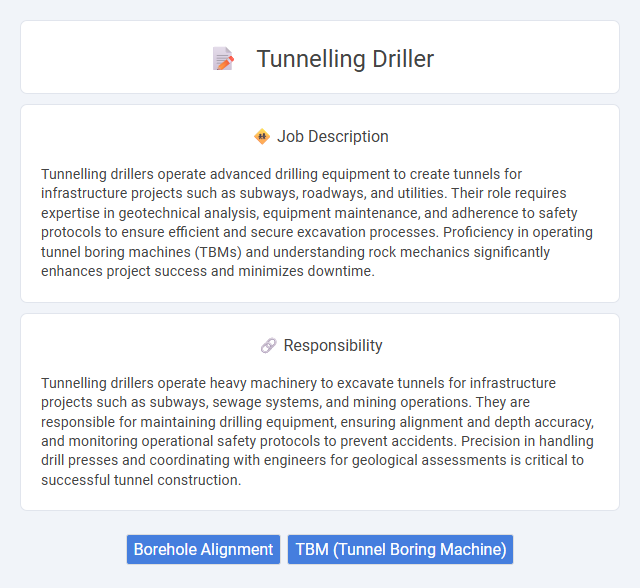
Tunnelling drillers operate advanced drilling equipment to create tunnels for infrastructure projects such as subways, roadways, and utilities. Their role requires expertise in geotechnical analysis, equipment maintenance, and adherence to safety protocols to ensure efficient and secure excavation processes. Proficiency in operating tunnel boring machines (TBMs) and understanding rock mechanics significantly enhances project success and minimizes downtime.
Tunnelling drilling is likely suitable for individuals with strong physical stamina and the ability to work in confined, often dark and noisy environments. People who are comfortable with teamwork, have good problem-solving skills, and can handle high-pressure situations may also find this job fitting. Those prone to claustrophobia or who struggle with physically demanding tasks might find the conditions challenging and less appropriate.
Qualification
Tunnelling driller positions require specialized training in heavy machinery operation and geological assessment, often necessitating certification in tunnel boring equipment. Candidates typically need a high school diploma or equivalent, complemented by vocational courses or apprenticeships in drilling technology. Proficiency in safety protocols, technical maintenance, and an understanding of soil and rock mechanics are essential qualifications for ensuring efficient and secure tunnel excavation.
Responsibility
Tunnelling drillers operate heavy machinery to excavate tunnels for infrastructure projects such as subways, sewage systems, and mining operations. They are responsible for maintaining drilling equipment, ensuring alignment and depth accuracy, and monitoring operational safety protocols to prevent accidents. Precision in handling drill presses and coordinating with engineers for geological assessments is critical to successful tunnel construction.
Benefit
Tunnelling drillers likely experience significant job security due to ongoing infrastructure development projects worldwide. They may benefit from competitive salaries and opportunities for overtime pay given the demanding nature of the work. Access to specialized training and advanced technology could enhance their skills and career progression within the mining and construction industries.
Challenge
Tunnelling drillers likely face significant challenges due to the demanding underground environment, including limited visibility and confined spaces. Equipment maintenance and operation under high pressure and potential rock instability may further complicate their tasks. Safety risks and the need for precise control increase the probability that this job requires specialized skills and constant vigilance.
Career Advancement
Tunnelling drillers gain expertise in operating heavy machinery to excavate underground tunnels for infrastructure projects, positioning themselves for roles such as site supervisors or drilling engineers. Mastery of advanced drilling techniques and safety protocols enhances employability and opens opportunities to manage larger projects or specialize in geotechnical consulting. Continuous certifications in drilling technology and project management accelerate career progression within construction and mining sectors.
Key Terms
Borehole Alignment
Tunnelling drillers specialize in precise borehole alignment to ensure optimal tunnel structural integrity and safety. They utilize advanced drilling equipment and laser guidance systems to maintain directional accuracy throughout the tunnelling process. Accurate borehole alignment minimizes risks of deviations, reduces material wastage, and enhances overall project efficiency.
TBM (Tunnel Boring Machine)
Tunnelling drillers operate Tunnel Boring Machines (TBMs) to excavate tunnels through various soil and rock strata with precision and efficiency. They monitor TBM parameters such as thrust force, rotation speed, and cutterhead torque to ensure optimal machine performance and safety. Expertise in interpreting geological data and maintaining the TBM's mechanical components is essential for minimizing downtime and maximizing project productivity.
 kuljobs.com
kuljobs.com